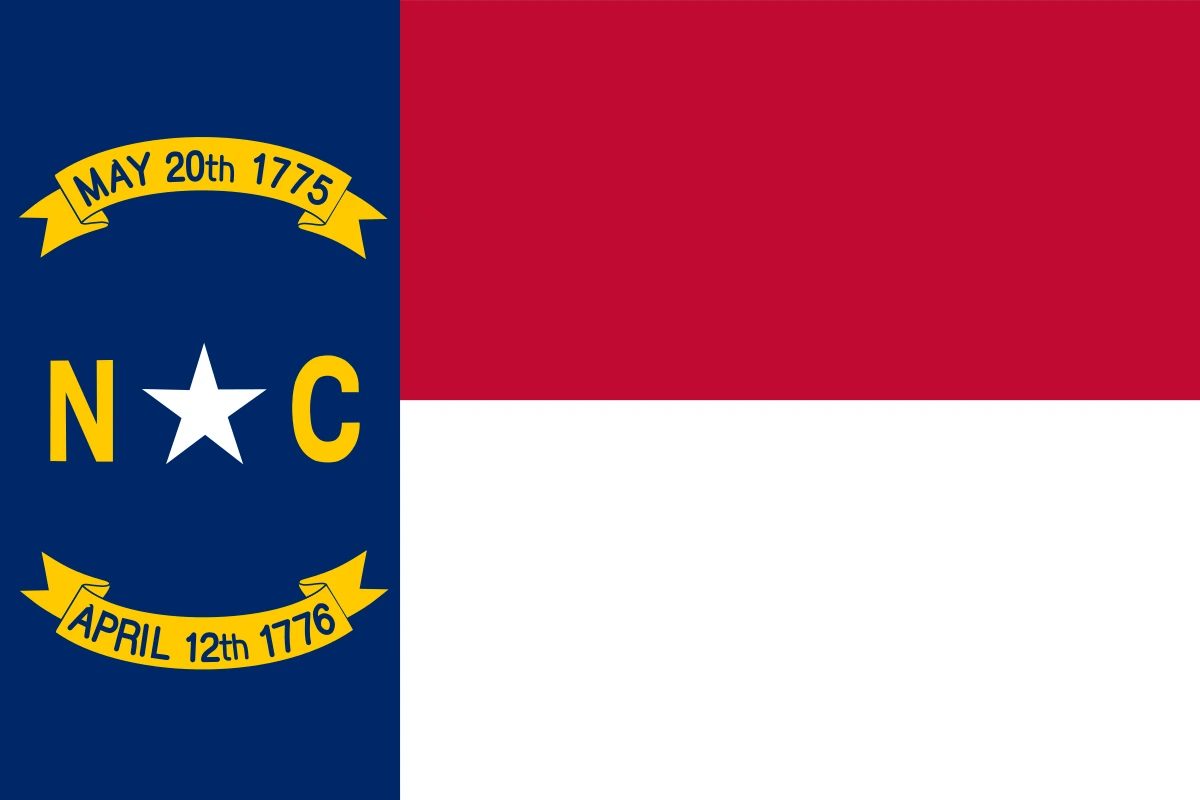
North Carolina, known for its rich history, diverse landscapes, and vibrant culture, is a state that offers a wealth of interesting facts and trivia. From notable figures who have shaped the nation to stunning natural attractions and a strong agricultural economy, North Carolina has much to explore and appreciate. Here are some intriguing highlights that showcase the unique characteristics and contributions of this Southern state.
Statehood: North Carolina became the 12th state to ratify the U.S. Constitution on November 21, 1789, following a tumultuous period of debate about federalism and state rights. Initially, North Carolina was one of the original thirteen colonies and played a significant role in the American Revolution. The ratification process was marked by a strong emphasis on individual rights, leading to the eventual adoption of the Bill of Rights. The state’s early government structure was influenced by its colonial past, and its ratification was critical in shaping the new nation.
Capital: Raleigh, founded in 1792, was selected as the capital of North Carolina due to its central location, which was intended to make government more accessible to the state’s citizens. Designed by the architect William Christmas, the city was named after Sir Walter Raleigh, who sponsored attempts to establish the first English colony in America. Raleigh is part of the Research Triangle, which includes Durham and Chapel Hill, and is known for its universities and research institutions. The city has grown into a vibrant cultural and economic hub, with numerous museums, parks, and a rich history.
Largest City: Charlotte, with a population of over 890,000 as of the 2020 census, is the largest city in North Carolina and one of the fastest-growing cities in the United States. Known as a major financial center, Charlotte is home to the headquarters of Bank of America and the east coast operations of Wells Fargo. The city boasts a diverse economy, with significant contributions from sectors such as technology, healthcare, and manufacturing. Additionally, Charlotte is recognized for its sports teams, including the NFL’s Carolina Panthers and the NBA’s Charlotte Hornets, and offers a vibrant arts and entertainment scene.
Geography: North Carolina covers a total area of 53,819 square miles, making it the 28th largest state in the U.S. The state features a diverse landscape that includes the Atlantic coastline, the rolling hills of the Piedmont region, and the majestic mountains of the Appalachian range. This geographical diversity contributes to a variety of ecosystems and climates, supporting rich biodiversity. The state’s geography also plays a crucial role in its economy, with agriculture thriving in the fertile plains and tourism flourishing in the mountainous and coastal areas.
Mount Mitchell: Mount Mitchell, standing at 6,684 feet (2,037 meters), is the highest point in North Carolina and the eastern United States. Located in the Black Mountain range of the Appalachian Mountains, it was named after Elisha Mitchell, a professor who was instrumental in measuring its height in the 19th century. Mount Mitchell State Park, established in 1915, offers hiking trails, stunning vistas, and a unique ecosystem that includes rare plant species. The area is popular among outdoor enthusiasts for activities such as hiking, birdwatching, and camping, and it provides a glimpse into the natural beauty of the region.
Outer Banks: The Outer Banks are a series of barrier islands off the coast of North Carolina, known for their stunning beaches, unique wildlife, and rich history. Stretching over 100 miles, these islands are separated from the mainland by the Pamlico Sound and are famous for their lighthouses, such as the Cape Hatteras Lighthouse, which is the tallest brick lighthouse in the U.S. The area is also significant in aviation history, being the site of the Wright brothers’ first flight. The Outer Banks attract tourists for water sports, fishing, and historical sites, making them a vital part of North Carolina’s tourism industry.
First in Flight: On December 17, 1903, the Wright brothers, Orville and Wilbur, made their first powered flight at Kitty Hawk, North Carolina, marking a monumental achievement in aviation history. The flight lasted 12 seconds and covered 120 feet, demonstrating the feasibility of controlled, powered flight. This event is celebrated annually in Kitty Hawk, where the Wright Brothers National Memorial commemorates their contributions to aviation. The brothers’ innovative spirit and engineering prowess have inspired generations and solidified North Carolina’s reputation as the “First in Flight.”
Biltmore Estate: The Biltmore Estate, located in Asheville, is the largest privately-owned home in the United States, encompassing 250 rooms and situated on 8,000 acres of beautifully landscaped grounds. Built by George Washington Vanderbilt II in the late 19th century, the estate features a blend of architectural styles, including Châteauesque and Renaissance. The estate is renowned for its impressive art collection, gardens designed by Frederick Law Olmsted, and its winery. The Biltmore Estate attracts over a million visitors each year, serving as a prominent example of America’s Gilded Age and a testament to the Vanderbilts’ legacy.
State Bird: The Northern Cardinal was designated as the state bird of North Carolina in 1943. This vibrant bird, known for its striking red plumage in males and a more subdued brownish hue in females, is a common sight across the state. Cardinals are non-migratory and can be found year-round, making them a familiar presence in backyards and parks. Their distinctive songs and calls contribute to the natural soundscape of North Carolina, and they are often associated with good luck and positive symbolism in various cultures. The Northern Cardinal’s popularity as a state symbol reflects North Carolina’s appreciation for its diverse wildlife.
State Flower: The flowering dogwood (Cornus florida) was officially designated as the state flower of North Carolina in 1941. This beautiful tree is celebrated for its stunning white or pink blossoms that bloom in early spring, providing a picturesque display across the state. The flowering dogwood is not only cherished for its aesthetic appeal but also holds cultural significance, as it is often associated with the arrival of spring and renewal. The tree thrives in various environments, from forests to residential areas, and its wood is valued for its strength and durability. The flowering dogwood is a symbol of North Carolina’s natural beauty and serves as a reminder of the state’s rich flora.
Tobacco Production: North Carolina is the leading producer of tobacco in the United States, historically playing a crucial role in the state’s economy. In the early 20th century, the state became the center of the tobacco industry, particularly for flue-cured tobacco, which is primarily used for cigarettes. The state’s favorable climate and rich soil conditions contribute to the high quality of its tobacco. At its peak, North Carolina produced over 600 million pounds of tobacco annually, making it a vital cash crop for many rural communities. Although the industry has faced challenges due to health concerns and changing consumer preferences, tobacco remains an important agricultural product in North Carolina.
Research Triangle: The Research Triangle, which includes Raleigh, Durham, and Chapel Hill, is one of the largest research parks in the world, established in the 1950s. It is named after the three major research universities in the area: North Carolina State University, Duke University, and the University of North Carolina at Chapel Hill. The Triangle is known for its innovation and technology-driven economy, hosting numerous research institutions, biotech companies, and startups. It attracts highly educated professionals and contributes significantly to the state’s economic growth. The area is also recognized for its quality of life, cultural amenities, and vibrant communities.
Population: As of the 2020 census, North Carolina has a population of approximately 10.4 million people, making it the ninth most populous state in the United States. The state has experienced significant population growth over the past few decades, driven by factors such as a strong economy, diverse job opportunities, and a desirable climate. Major urban areas like Charlotte and Raleigh have seen rapid development, while rural regions maintain their unique charm. This population diversity contributes to a rich cultural tapestry, with various ethnicities, traditions, and lifestyles coexisting across the state.
Longest River: The Cape Fear River is the longest river in North Carolina, stretching about 202 miles (325 kilometers) from its origin in the western part of the state to its mouth at the Atlantic Ocean near Wilmington. The river has played a vital role in the state’s history, serving as a transportation route for goods and people since colonial times. It is also a significant source of water for agriculture and industry. The Cape Fear River basin supports diverse ecosystems and recreational activities such as fishing, kayaking, and hiking along its banks, making it an important natural resource for both residents and visitors.
Great Smoky Mountains: A portion of the Great Smoky Mountains National Park, which is the most visited national park in the United States, is located in North Carolina. Established in 1934, the park spans over 800 square miles and is renowned for its biodiversity, with thousands of plant and animal species inhabiting the area. The park features stunning landscapes, including lush forests, cascading waterfalls, and panoramic mountain views. Visitors can enjoy a variety of outdoor activities, such as hiking, camping, and wildlife viewing. The Great Smoky Mountains are also a UNESCO World Heritage Site, recognized for their natural beauty and cultural significance.
Historic Sites: North Carolina is home to several historic sites, including Roanoke Island, the site of the first permanent English settlement in America. Established in 1587, the Roanoke Colony was an ambitious attempt by Sir Walter Raleigh to establish a foothold in the New World. However, the colony mysteriously vanished, leading to one of the greatest unsolved mysteries in American history. Today, Roanoke Island is a popular tourist destination, featuring attractions like the Roanoke Island Festival Park and the Elizabethan Gardens, which celebrate the island’s rich history and cultural heritage.
Civil War Battles: North Carolina was the site of several significant battles during the Civil War, including the Battle of Bentonville, which took place from March 19 to 21, 1865. This battle was one of the last major engagements of the war and involved a fierce confrontation between Union General William Tecumseh Sherman and Confederate General Joseph E. Johnston’s forces. The battle is notable for its scale and the strategic maneuvers employed by both sides. Today, Bentonville Battlefield is preserved as a historic site, allowing visitors to learn about the Civil War’s impact on North Carolina and the nation.
Famous People: North Carolina has been the birthplace and home to several notable figures throughout history. Among them is President Andrew Jackson, the seventh president of the United States, who served from 1829 to 1837. Jackson, known for his populist approach and controversial policies such as the Indian Removal Act, was born in the Waxhaws region, which straddles the North Carolina-South Carolina border. Additionally, the state is home to acclaimed author Thomas Wolfe, whose works, including “Look Homeward, Angel,” reflect his experiences growing up in Asheville, North Carolina. Wolfe’s literary contributions have made a lasting impact on American literature, and he is celebrated for his vivid prose and exploration of personal and regional identity.
State Animal: The Eastern Gray Squirrel (Sciurus carolinensis) was designated as the state mammal of North Carolina in 1969. This common species is known for its bushy tail and gray fur, and it can be found throughout the state, thriving in both urban and rural environments. Eastern Gray Squirrels are particularly notable for their role in forest ecosystems, as they help in seed dispersal, which contributes to the growth of trees and plants. Their adaptability to various habitats, including parks and suburban areas, makes them a familiar sight for residents and visitors alike.
Blue Ridge Parkway: The Blue Ridge Parkway is a renowned scenic highway that stretches 469 miles through North Carolina and Virginia, connecting the Great Smoky Mountains National Park to Shenandoah National Park. Established in 1936, the parkway is celebrated for its breathtaking views, diverse ecosystems, and recreational opportunities. The road features numerous overlooks, hiking trails, and picnic areas, attracting millions of visitors each year who come to experience the stunning landscapes, particularly during the fall when the foliage transforms into vibrant hues of red, orange, and yellow. The Blue Ridge Parkway is often referred to as “America’s Favorite Drive” and is a vital part of the region’s cultural and natural heritage.
Climate: North Carolina boasts a diverse climate that varies significantly across its regions. The eastern part of the state experiences a humid subtropical climate, characterized by hot summers and mild winters, which supports a variety of agricultural activities. In contrast, the mountainous areas in the western part of the state have a temperate climate, with cooler temperatures and higher precipitation levels, making them ideal for outdoor activities such as hiking and skiing. This climatic diversity contributes to the state’s rich biodiversity, allowing for a wide range of flora and fauna to thrive in different environments.
State Song: “The Old North State” was adopted as the state song of North Carolina in 1927, reflecting the pride and heritage of its residents. The song was written by William Gaston, a prominent politician and jurist, with music composed by J. S. McCorkle. The lyrics celebrate the beauty and history of North Carolina, emphasizing themes of loyalty and love for the state. It is often performed at public events, school functions, and state ceremonies, serving as a reminder of the state’s cultural identity and the values held by its people.
Largest Lake: Lake Norman is the largest man-made lake in North Carolina, covering a surface area of 32,475 acres. Created in 1963 by the construction of the Cowans Ford Dam on the Catawba River, Lake Norman serves as a significant recreational area for boating, fishing, and swimming. The lake has become a popular destination for both residents and tourists, with numerous parks, marinas, and waterfront communities lining its shores. Its expansive waters not only provide recreational opportunities but also play a crucial role in the local economy, supporting tourism and real estate development in the surrounding areas.
Economy: North Carolina’s economy is diverse and robust, ranking among the top states in the United States for agricultural production. The state is particularly known for its poultry, hogs, and corn, with extensive farming operations that contribute significantly to both local and national markets. North Carolina is also a leader in the production of sweet potatoes and tobacco, and its agricultural sector benefits from the state’s favorable climate and fertile soil. In addition to agriculture, North Carolina’s economy is bolstered by industries such as technology, finance, and manufacturing, making it a dynamic state with a variety of economic opportunities.
University System: The University of North Carolina system, established in 1789, is one of the oldest public university systems in the United States. It comprises 17 campuses, including the flagship University of North Carolina at Chapel Hill, which is known for its academic excellence and research contributions. The system plays a vital role in providing higher education to residents of North Carolina and beyond, offering a wide range of undergraduate and graduate programs. The University of North Carolina system is also recognized for its commitment to public service, research, and fostering economic development within the state, making it a cornerstone
Frequently Asked Questions About North Carolina
Geography and Climate
- What are the main geographic regions of North Carolina?
- North Carolina is divided into three main geographic regions: the Coastal Plain, the Piedmont, and the Mountains. The Coastal Plain is a low-lying region bordering the Atlantic Ocean. The Piedmont is a hilly region between the Coastal Plain and the Mountains. The Mountains region is home to the Blue Ridge Mountains, which are the highest mountains east of the Mississippi River.
- What is the climate like in North Carolina?
- North Carolina has a humid subtropical climate, which means it has hot, humid summers and mild winters. The climate varies depending on the region. The Coastal Plain has a milder climate, while the Mountains have a colder climate.
- What is the highest point in North Carolina?
- The highest point in North Carolina is Mount Mitchell, which is located in the Blue Ridge Mountains. Mount Mitchell is 6,684 feet (2,037 meters) high.
- What are the major cities in North Carolina?
- The major cities in North Carolina include Raleigh, Charlotte, Greensboro, Winston-Salem, Durham, Asheville, and Fayetteville.
History and Culture
- When did North Carolina become a state?
- North Carolina became a state on November 21, 1789.
- What is the nickname of North Carolina?
- North Carolina is often called the “Tar Heel State.”
- What is the state bird of North Carolina?
- The state bird of North Carolina is the cardinal.
- What is the state flower of North Carolina?
- The state flower of North Carolina is the dogwood.
- What are some famous people from North Carolina?
- Some famous people from North Carolina include Michael Jordan, Andrew Jackson, Maya Angelou, and Billy Graham.
Tourism and Attractions
- What are some popular tourist destinations in North Carolina?
- Some popular tourist destinations in North Carolina include the Outer Banks, Asheville, the Great Smoky Mountains National Park, and the Biltmore Estate.
- What are some popular things to do in North Carolina?
- Some popular things to do in North Carolina include hiking, camping, fishing, surfing, visiting museums, and attending festivals.
- What is the best time to visit North Carolina?
- The best time to visit North Carolina depends on what you want to do. Spring and fall are generally the most pleasant times to visit, as the weather is mild and there are fewer crowds. Summer is a popular time to visit the beaches, and winter is a good time to visit the mountains for skiing and snowboarding.
Economy and Education
- What is the economy of North Carolina like?
- North Carolina has a diverse economy, with major industries including manufacturing, agriculture, finance, and technology.
- What are the major universities in North Carolina?
- The major universities in North Carolina include the University of North Carolina at Chapel Hill, North Carolina State University, Duke University, Wake Forest University, and Appalachian State University.
- What is the cost of living in North Carolina like?
- The cost of living in North Carolina varies depending on the location. Overall, the cost of living in North Carolina is relatively affordable compared to other states in the United States.









